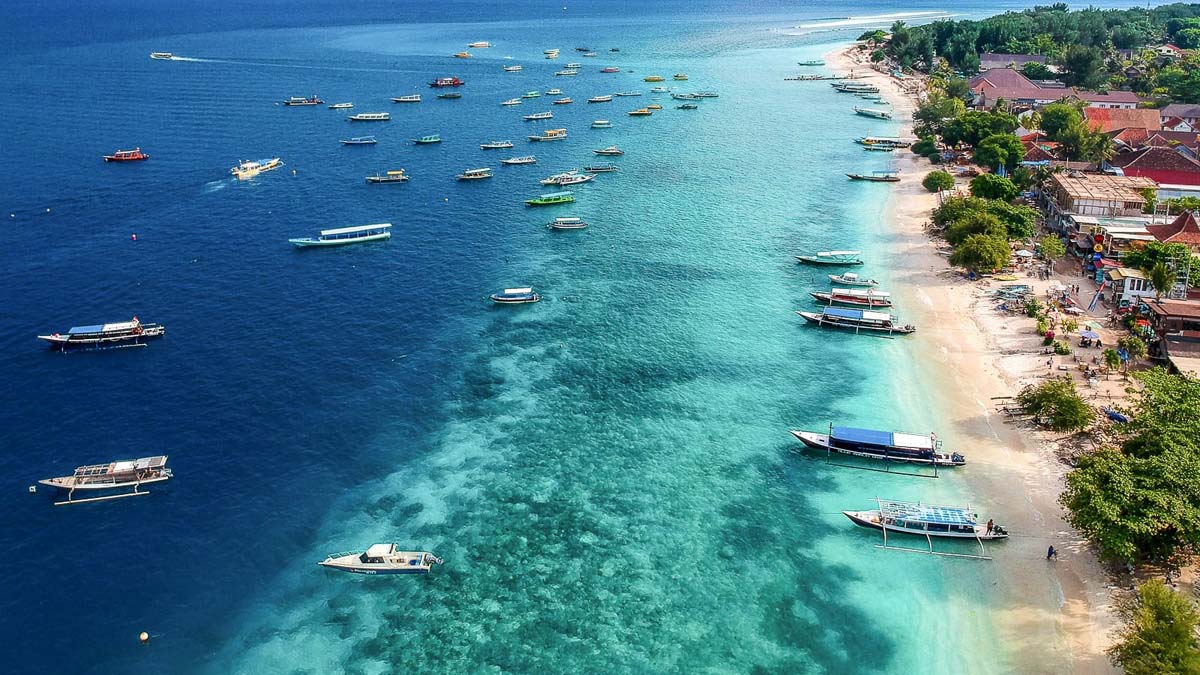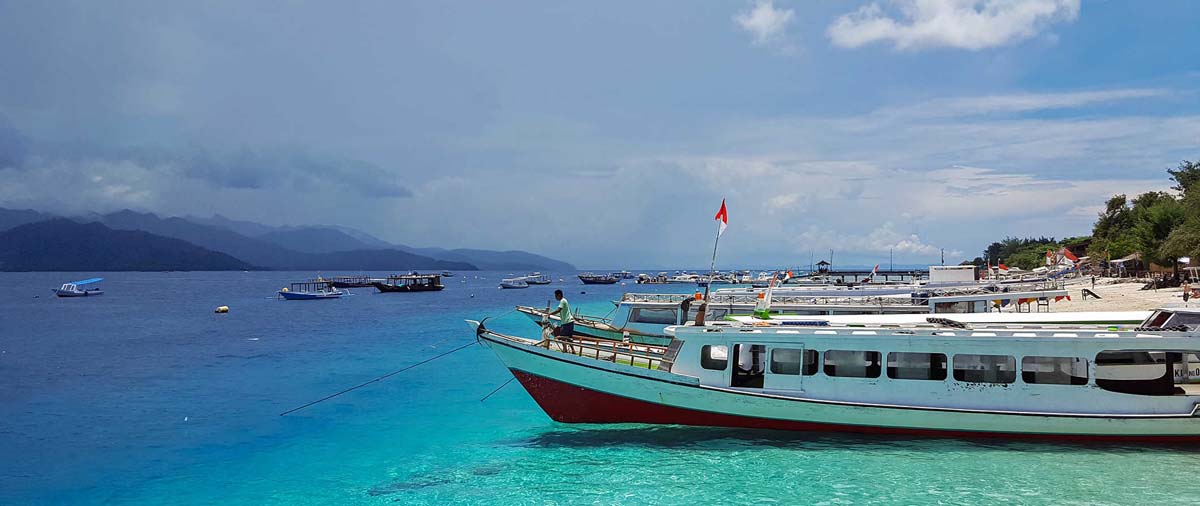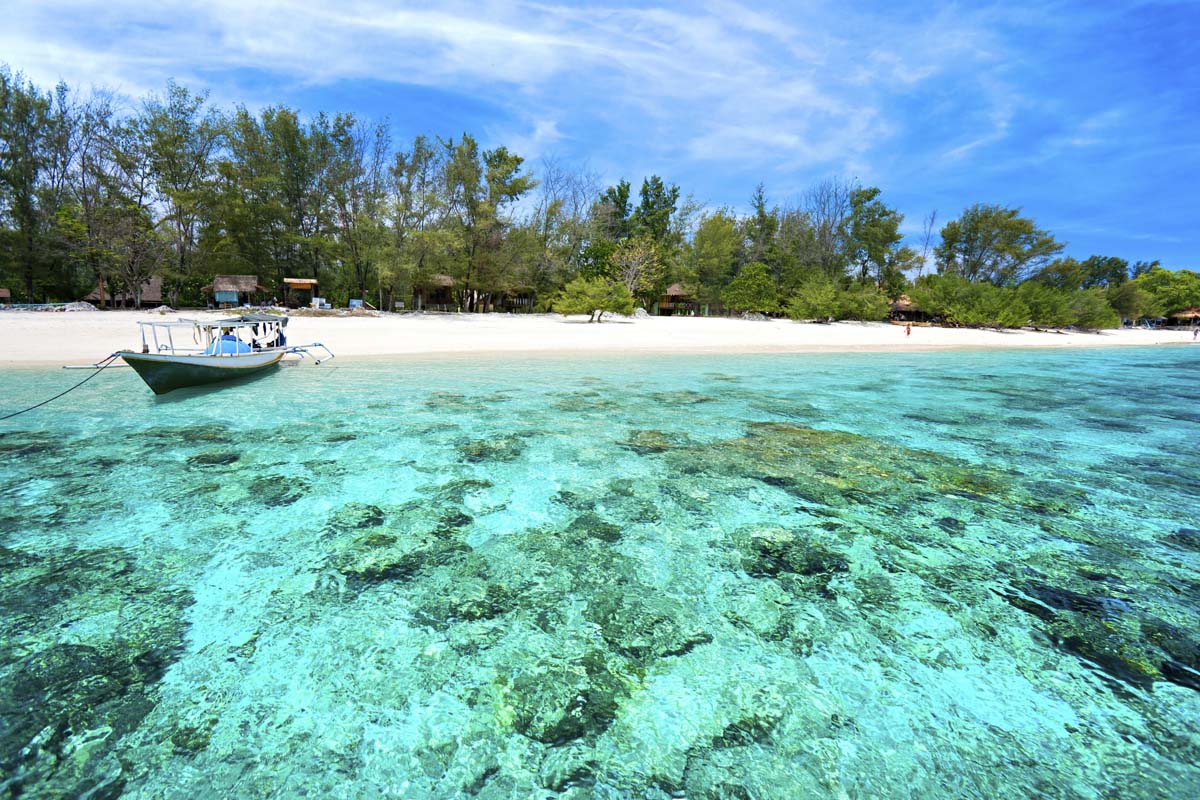















The Gili Islands (Indonesian: Tiga Gili [Three Gilis], Kepulauan Gili [Gili Islands]) are an archipelago of three small islands or Gili island triplets[1] — Gili Trawangan, Gili Meno and Gili Air — just off the northwest coast of Lombok, Indonesia.
The islands are a tourist destination. Each island has several resorts, usually consisting of a collection of huts for tourists, a small pool and restaurant. The largest Indonesian settlement is located on Gili Air, however due to the amount of western expatriates who live on Trawangan together with the locals, it has become the more densely populated island, concentrated in a township stretching along its east side (this is also where the majority of tourist development has taken place). Automobiles and motorized traffic are prohibited on the islands by local ordinance, so the preferred method of transportation is by foot and bicycle or the horse-drawn carriage called a cidomo. Scuba diving and free diving in and around the Gilis is also common due to the abundance of marine life and coral formations. Most famous diving spots are Shark point, Manta point and Simon’s reef.[2]
The Islands are located in the Lombok Strait, to the immediate northwest of Lombok. They extend outward from a tiny peninsula called Sire near to the village of Tanjung on Lombok. Bali lies about 35 km to the west of Gili Trawangan, the islands’ most westerly member. Both Bali and Lombok are easily visible from the Gilis in clear weather. Mount Rinjani, Indonesia’s second highest volcano, is close by on neighbouring Lombok, and dominates the views towards the east.
Due to their close proximity to the Equator, the Islands have a warm, tropical climate with a dry and wet season. With Mount Rinjani to the immediate east on Lombok, and Mount Agung to the west on Bali, The Gilis are somewhat sheltered and actually enjoy a slightly drier microclimate when compared to the surrounding archipelago. Dry Season usually lasts from May until October, with monsoon season starting in November and continuing through to April. Temperatures range between 22 °C to 34 °C, with an average annual temperature of around 28 °C.[3]
Gili Trawangan, or colloquially Gili T, is the largest of Lombok‘s Gili Islands and the only one to rise significantly (30 m) above sea level. Measuring 3 km long and 2 km wide, it has a population of around 1500 (see demography). The name Trawangan originates from the Indonesian word Terowongan (Tunnel) due to the presence of a cave tunnel built there during Japanese occupation in World War 2.[6] Japanese presence during the second world war was on elevated topography in the South of the island, where anti-aircraft guns were housed. Only the base of the AA guns remains at the end of the tunnel. Of the Gilis, Trawangan is the most developed and geared towards tourism. The main concentration of settlement, recreation, accommodation and diving business is situated on the eastern side of the island. A local pub, Tír na Nóg claims that Trawangan is the smallest island in the world with an Irish pub. It was previously administered under Lombok Barat Regency along with Senggigi until 2010 when the Gili islands came under the jurisdiction of the new North Lombok Regency (Kabupaten Lombok Utara).[7]
On Gili Trawangan (as well as the other two Gilis), there are no motorised vehicles. The main means of transportation are bicycles (rented by locals to tourists) and cidomo (a small horse-drawn carriage). For travelling to and from each of the Gilis, locals usually use motorised boats and speedboats.
Some of the first inhabitants of Gili Trawangan were fishermen and farmers from Sulawesi. Previous to human settlement Gili Trawangan was covered in forest and deer lived on the island. (Source: Inhabitants of Gili Trawangan — no printed source available).[verification needed]
The economy of Gili Trawangan centres on tourism, as the island is too small to support any broad scale agriculture, and too remote to allow economically viable industry or commerce. There is a mosque on the island.
Gili Meno is the middle of Lombok‘s three northwest coast Gilis. Gili Meno has a population of about 500, mainly concentrated on the centre of the island (see section on demography). The main income comes from tourism, coconut plantation and fishing. On the west side of the island there is a small shallow lake that produces salt in the dry season. Until a few years ago there was also a small production of seaweed on the reef at the north end of the island. Gili Meno has swimming beaches all around the island, and a turtle sanctuary.
The island attracts fewer tourists than Gili Trawangan and is the quietest and smallest of the islands. However, honeymooners are often drawn to the crystal clear water and idyllic, secluded white beaches.
Since early 2017 fresh water was installed on the island and is supplied by underwater pipes from Lombok. Electricity is supplied by underwater cables from Lombok. There are no cars or motorbikes.
Gili Air is the second smallest of the islands and the closest to mainland Lombok, making it popular with honeymoon couples and travellers seeking a quiet retreat. It has a population of about 1,800. The island offers excellent snorkelling and scuba diving off its east coast, and turtles can be seen along the coral reef. Other water sports such as Stand Up Paddleboarding and Kitesurfing are also now available. An Indonesian cooking school has opened its door on the harbour in 2015 Gili Cooking Classes. Gili Air also has a public gym.[8]
Continued investment in tourism is resulting in rapid development of the islands, and each year sees new resorts and accommodation on the islands while attempting to retain their individual character. Proximity to Gili Meno, the smallest and most secluded of the islands and to Gili Trawangan the largest island, known for its many restaurants and parties, makes Gili Air a destination that combines relative seclusion with adequate services.[citation needed] Both other Islands are a quick boat ride away.

Subscribe now and be the first to know about our special deals, promotions and offers!
Type your keyword on the search box below.
This will close in 0 seconds
